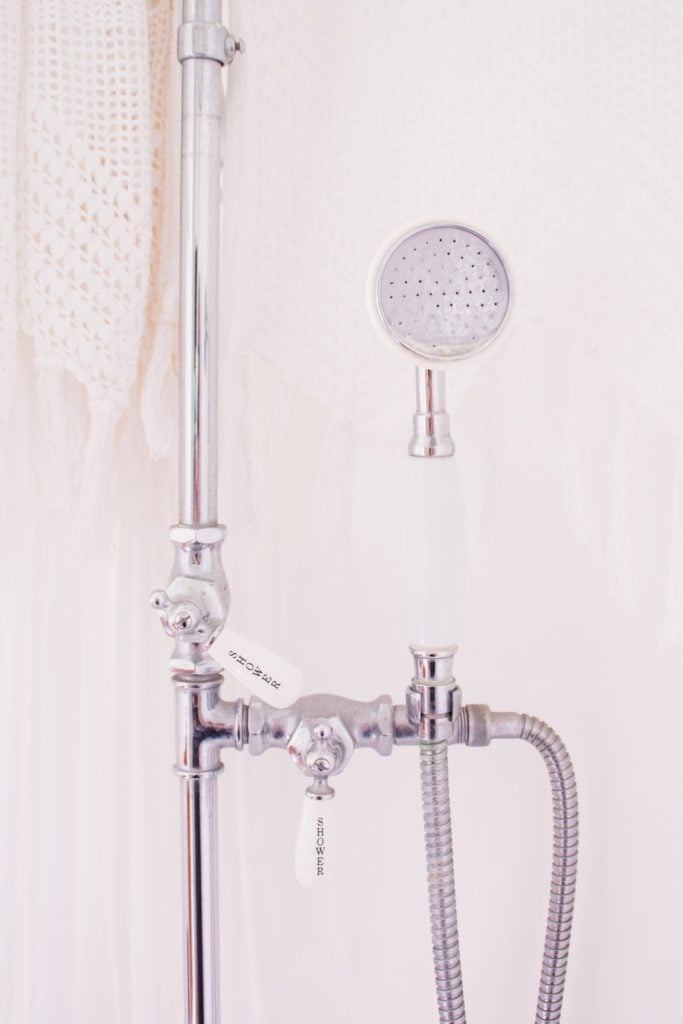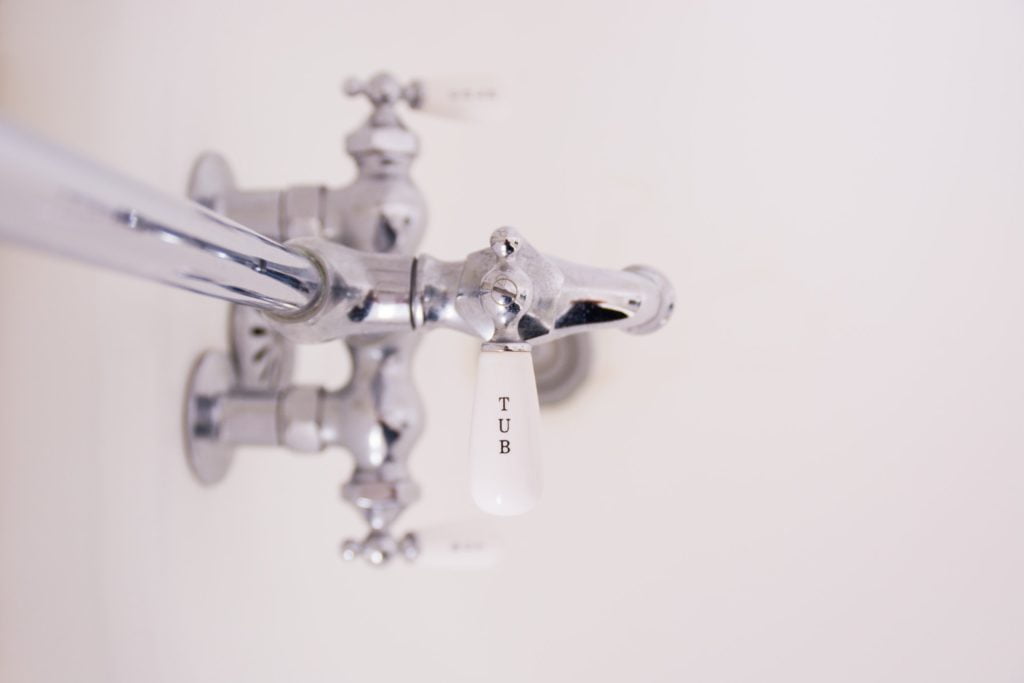Hard water is when the water has oxides of metals like Calcium and Magnesium, which makes the soap unable to form lather. What this can also do is clog water pipelines by forming mineral deposits.

While city officials take care of the deposits formed underground and in-house pipelines, what they do don’t do is take care of the shower-heads.
That one’s on you.
You may have seen something nasty clogging in the shower head holes sometimes. That’s calcium, which if not removed will keep on depositing on the shower head until its wholly blocked.
It shortens the span of life of the shower-head. It can ruin the paint, can cause corrosion and make water coming out of it harmful for your skin and scalp. Calcium and other mineral particles can get accumulated on the skin and scalp causing hair loss and pimples.
So it is indispensable to keep the shower head free of all the mineral build up. It’s good for the life of the shower-head, and it’s good for you. Now, let’s talk about how to do it.
While getting a super expensive cleaning solution can do the work, but that’ll be overkill. Household distilled vinegar is enough for the job. It’s simple and almost effortless.
So, here’s a guide on how to remove calcium deposits from shower-heads Easily!
Related Articles
Top 10 Best High Pressure Shower Heads of 2022 | Editor’s Top Choices
99 Super Cool Shower Curtains to Transform Your Bathroom Today
How to Remove Calcium Deposits from Shower-heads

How to Remove Calcium Deposits with Shower-head Removal
- Step 1 – Remove the shower-head
Get an adjustable wrench and slowly loosen the bolt that attaches the head to the wall. Do it slowly and carefully.
If the calcium deposit is too massive, then you might have a hard time doing it. The tip is to put adequate pressure and have patience. Once it’s almost out, use your hands to unscrew it completely.
Always remember that shower-heads are significantly weighted, so be careful and deliberate, or you may hurt yourself.
- Step 2 – Prepare the cleaning solution
Now take a plastic bag, pour a cup of water in it. And then add a cup of distilled vinegar in it. Have enough solvent in the packet to entirely submerge the shower-head.
Leave it unattended for about an hour. After that, you should see that calcium deposits have disintegrated and detached from the shower-heads body. But if not so, wash it and do it again with a higher concentration of vinegar.
A fair warning will be not to make it too concentrated. It may damage the paint.
Once, you get satisfying results. Get ready from some scrubbing.
- Step 3 – Cleaning the shower-head
Rinse the shower head with some water. Now, use a metal sponge to scrub in a circular motion. Do it nice and smooth. Otherwise, you’ll scratch the surface of the shower head.
If done correctly, the treated calcium deposits should be entirely off the surface. Now place the shower head under running water in a sink. It will make sure that no residual calcium is left.
Once done, dry off the shower head for easy fitting. Use an adjustable wrench to fit it on the wall again.

How to Remove Calcium Deposits Without Removing the Shower-head
Here is one more straightforward way that does the trick. It’s a simpler trick that works better for low to moderate deposits.
- Step 1 – Prepare the solution
As mentioned in step 2 of the previous method, take a bag and make a vinegar solvent. Now submerge the attached shower-head in the bag of solvent and using tape or rubber bands, wrap it around the shower-head.
Leave it in that state for about an hour. Now be careful to not spill it over your face or eyes while you do it. If it happens by accident, rinse your eyes with clean water immediately.
- Step 2 – Washing the shower-head
Take the bag off of the shower head. Now pour a mug of water over the shower head and gently scrub with a piece of cloth afterward. Run water through the shower for some time. So that all the residue gets out and no vinegar is left in the shower-head.
Use a brush to scrub the holes of the shower-head so if there are some small calcium particles in the faucet; make sure they get out as well. Have patience and do it thoroughly to have a good result.
Obviously, this method doesn’t work as good as the first one. Some calcium deposits and particles may get left out as the water rinse is not thorough enough. In that case, it’s just better to take the faucet off and do it properly.
If the calcium deposits are too much, then it won’t work at all. So if you see that the deposit is way too much, then go with method number one.

Image via Abigail Lynn@shmabbss
- Why Vinegar
Vinegar has acetic acid which is an excellent solvent to dissolve mineral deposits. Since it’s a natural chemical, it produces no harmful fumes while cleaning or anything like that.
It’s also extremely inexpensive. Worth pennies for every cleaning session and you’ll save quite a few dollars if you use this over some specialty cleaner from the supermarket.
But be careful with vinegar. Be sure to avoid contact with your eyes. If you do happen to get vinegar in your eyes accidentally, wash them with clean water.
Also, keep vinegar out of the reach of your kids. A significant amount of vinegar can be poisonous for adults, and it’s even worse for kids.
- Preventing calcium deposits
Keeping the bathtub and shower clean can help reduce the chances of getting calcium deposits. Just use a towel or sponge to wipe off the wet surface of your tub and shower.
It hardly takes a minute or two, so it’s a matter of habit only. And It’s a good habit indeed. Your bathroom will thank you for it.
Hard water can have some adverse effects on the skin and can be poisonous on ingestion. High mineral content can also cause hair loss because fine particles settle on the scalp.
So, if your local water source is exceptionally hard, then do consider installing a water softener system. It’ll remove all the extra minerals in the water causing deposits.
While it will be good news for your hair and skin, you also won’t have to worry about cleaning the shower head as often.

Image via Abigail Lynn@shmabbss
Final Words
So there you have it — two methods to clean shower-heads.
Mineral deposits can harm the shower-head as well as the health of your skin and hair. While installing a water softener can be an end all and be all solution to the problem, meanwhile, keeping the shower-head clean can help. Also, it’s much cheaper.
Remember, you don’t need some fancy specialty cleaner. Vinegar is fine for the job. Acetic acid is a fantastic solvent for these kinds of deposits, and it’s all natural and safe.
One important thing to remember is to be careful while scrubbing the shower head. Many times, while cleaning, I’d rub it too hard and hurt the paint on the body of the shower-head or directly chip it.
Also, be careful while taking out and installing back the shower heads. It’s a massive piece of metal, so it can seriously hurt you if you are not careful with it.
And that’ll be it. All the information one might need to clean and maintain shower heads and maybe more importantly, why.
With that, I hope this guide was helpful in your venture.
Related Articles
Top 10 Best High Pressure Shower Heads of 2022 | Editor’s Top Choices
Walk-in Showers 101 | Pros & Cons, Tips & Tricks, Design Ideas
99 Super Cool Shower Curtains to Transform Your Bathroom Today
11 Best Shower Body Sprays Today Reviewed
5 Best Shower Systems With Body Jets
11 Best Shower Curtain Rod Reviewed
